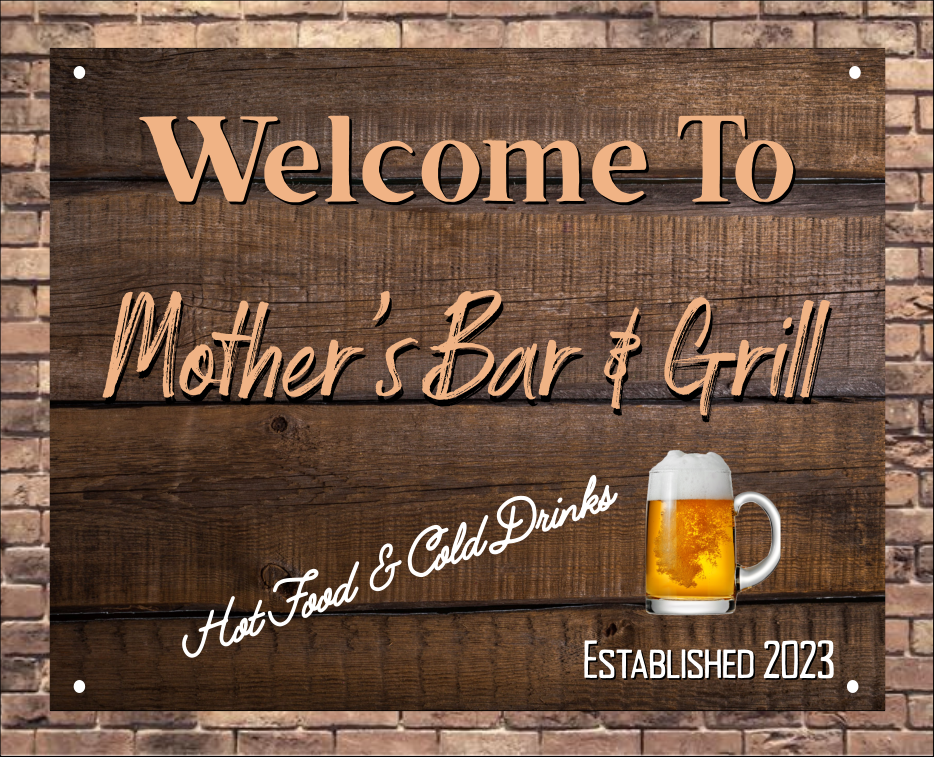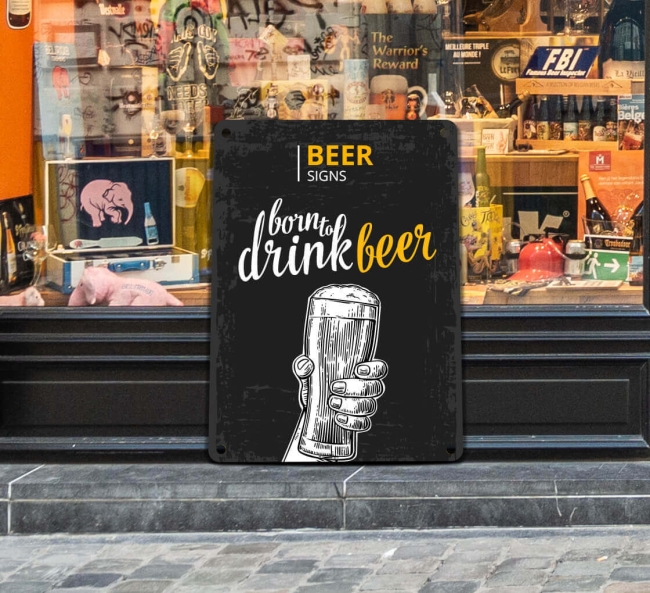Bar signs vary in size depending on their intended use, their location and aesthetic. The following are the ways that different sizes affect bar signs in terms of their functionality and appearance. Large Signs
Use to bring attention to an region and to serve as a central point.
Signage for exterior use, main branding signs, or walls with features.
The location is usually over entrances, outside bars or on large wall surfaces to draw patrons.
Examples: large neon signs such as vintage-style signs or mural signs.
2. Medium Signs
The idea is to provide details or to enhance the look of the room without taking up too much space.
Uses: menu boards, promotional displays, and signs for directional purposes.
Placement of signage: Ensure that the sign is clearly visible, but not too overwhelming.
You can use decorative signs or even metal signs to advertise your bar.
3. Small Signs
The purpose is to provide precise details or subtle decorative elements.
Applications: Small, decorative items or labels.
Placement: Displays and tables that are located close to the eye.
Examples: Small-framed quotes or drink cards.
Size Considerations
Visibility
Large Signs: Made to be visible from a distance, which makes the perfect choice for attracting people and establishing the bar's presence.
Medium Signs: Balances visibility with efficiency in space, and provides important information without overpowering the design.
Small signs are ideal for intimate details or close-ups. Helps enhance the customer's experience by putting them near the eyes.
Proportion
Large Signs: Should be proportionate to the space to avoid overwhelming smaller areas. Perfect for large or open spaces.
Medium Signs Medium Signs are ideal for many interior spaces. They are able to be positioned in many different ways.
Small Signs: Ideal way to add details, and fit neatly into small spaces.
Impact
Signs that are large in size make a strong and imposing statement. This is an important element in branding. They are often employed to set the atmosphere for an establishment.
Medium Signs: Strikes the right balance between décor and visibility, adding to the overall ambience while delivering vital information.
Small signs: They bring charm and detail to your visual experience while also enhancing it.
Practicality
Large Signs: require massive mounting solutions, and could cost more due to the size and the materials.
Medium Signs: Easier to install and reposition and reposition, they are flexible in design changes.
Small Signs: Highly versatile and easy to change or update perfect for environments that are constantly changing such as bars that have constantly changing menus or specials.
Functionality
Large signs are mostly practical and appealing.
Medium Signs are functional and decorative. They give you essential information and also enhance your aesthetic.
Small Signs: Created to provide precise information and support the theme in a subtle manner.
The size of bar signs is determined by their function their layout, as well as the effect they wish to create on patrons. The signs can contribute to the overall atmosphere and flow of the bar, if they are balanced. See the top the original source on bar sign outdoor for site tips including home bar pub signs, signs for garden bar, personalised pub signs for sale, home pub signs, home made bar sign, bar signs for home, novelty bar signs, bar signs for home bar, pub signs for garden, personalised home pub sign and more.

What Is The Distinction Between Bar Signs And Other Types Of Signage Regarding Light?
The lighting of bar signs could affect their visibility, ambiance and their overall impact. Here are some of the crucial ways in which lighting can affect bar signs. Neon Signs
Characteristics: Bright, colorful, classic.
Lighting: Make use of neon gas-filled tubes that emit light when charged.
Uses: Perfect for creating a retro or vintage look. Often used for bar names and logos.
Benefits: It's visible even at a distance and it is nostalgic.
The material is delicate and expensive to fix.
2. LED Signs
Characteristics: Energy-efficient, versatile, modern.
Lighting: Uses diodes that emit light to create brilliant light.
Uses: Suitable for both indoor and outdoor signs, programmable displays, and dynamic lighting effects.
Benefits: The LEDs last a long time, are energy efficient, and can be programmed to show animated or color changes.
The disadvantages are the initial cost, however, it is cheaper to pay for energy and maintenance costs.
3. Signs with Backlights
Characteristics: Elegant, sophisticated, subtle.
Lighting Lights: LEDs or fluorescent lights behind a transparent surface creates an ethereal glowing.
Uses: Often used for the menu boards or modern bar signs.
Benefits: Gives a neat and professional appearance, improves readability in low light.
Advantages: More complicated installation and cost-intensive upfront.
4. Signs Edge-Lit
Characteristics: Sleek, contemporary, stylish.
Lighting: LEDs can be used to light the edges of acrylic signs.
Applications: Suitable for modern, minimalist designs. Used to create informational or directional signage.
Benefits: Gives a refined and distinct look. Energy efficient.
Limitations: Only available in certain designs styles.
5. Ambient/Accent Lighting
Characteristics: Subtle, atmospheric, decorative.
Lighting: Utilizes indirect lighting sources to emphasize or highlight signs.
Applications: Improves ambience and can be used to show off artwork or theme decorations.
Advantages : It can add depth and atmosphere to an area by creating a cozy and inviting environment.
Disadvantages : Direct illumination may not be enough to read.
6. Marquee Signs
Characteristics: Bold, theatrical, eye-catching.
Lighting: Use a variety of LEDs or light bulbs around the edges of the sign.
Uses: Popular for outdoor signs, event advertising as well as creating a vintage cinema style.
Advantages: Highly visible and attracting attention.
The disadvantages are that it is costly and requires regular maintenance.
7. Projection Signs
Characteristics: Dynamic, innovative, versatile.
Lighting: project light and images using projectors on flat surfaces.
Applications include: promotions Events display, dynamic and temporary promotions.
Advantages: Easy to change No physical structure is required.
Negatives
8. Fluorescent Signs
Characteristics: Bright, cost-effective, traditional.
Lighting: Make use of fluorescent tubes to give light.
Commonly used to create bigger indoor or outdoor signs.
Benefits: Effective and bright for large signs. Costs are relatively low.
Advantages
Questions Concerning Lighting
Visibility
Neon-colored LEDs and signs are excellent for attracting people's attention, especially in dim lighting conditions.
Edge lit and backlit signs are great for improving reading ability and also creating a an appearance that is professional.
Energy Efficiency
LED signs: Energy efficient and long-lasting.
The neon signs and the fluorescent signs: Both are energy-inefficient. But neon signs are more fragile.
Aesthetic Appeal
Neon and marquee signs: perfect for vintage and retro aesthetics.
For modern, clean designs, edge-lit and backlit signs are ideal.
Ambient lighting enhances overall atmosphere.
Maintenance
LED Signs - Low Maintenance and Durable
Signs with fluorescent and neon lights require more frequent maintenance, and might require to be repaired.
Cost
LED Backlit Signs with High initial cost, but low operating costs.
Fluorescent signs are less expensive initially but they cost more in energy over time.
Flexibility
The Projection signs and LED signs give you a lot of flexibility when it comes to changing the display and content.
Traditional Signs Less flexible than other kinds of signs, but they provide a more specific look.
The proper lighting can create the right atmosphere and to effectively communicate with patrons. Take a look at the recommended pub signs url for site advice including home pub signs, pub signs for garden, hanging bar sign, bar sign design, personalised home bar signs, hanging bar sign, pub signs, hanging pub signs personalised, make a bar sign, hanging pub signs and more.

How Do Bar Signs Differ From Each Other In Terms Of Interactivity?
Bar signs may have different levels of interaction that can be used to interact with customers and improve the overall experience. Below are the distinctions between bar signs with respect to their interaction. Static Signs
Static Signs are static signs that provide information but do not include any interactive components.
Common Types: Printed posters, murals painted, or standard neon signs.
2. Digital Displays
Digital signs can be capable of showing live-time content, which includes animations, multimedia and updates.
Touchscreen displays allow for interactive menus and games as well as promotional content.
Benefits: Engage patrons to keep their attention, and provide relevant information.
3. QR Codes
QR Codes are able to link directly to social media profiles or menus.
Benefits: Access to information on promotions, further information or loyalty programs.
4. LED Screens
Dynamic Messaging: LED screens are able to display animated scrolling text or video clips.
Interactivity: LED screens let patrons interact, for example through menu selection or playing a game.
Benefits Include: Grab your audience's attention through creating experiences that are immersive.
5. Projection Mapping
Immersive experience Projection maps transform surface into dynamic displays and interactive images, allowing for storytelling.
Interactivity: Patrons are able to interact with interactive elements such as games or virtual experiences.
Benefits: Improve ambiance and social interaction, while delivering unforgettable memories.
6. Augmented Reality (AR)
Enhanced Reality: AR overlays digital content onto the physical environment, providing immersive experiences.
AR-enabled sign allows customers to interact with digital components such as viewing cocktail recipe or playing virtual games.
Benefits: Create distinctive experiences, draw patrons and set the bar from other bars.
7. Motion Sensors
Responsive Signage Motion sensors sense movement and trigger interactive responses on signs.
Interactivity - Signs can react by changing their content or displaying animations, as well as displaying personalized messages in response to the patrons' actions.
Benefits include: Increasing participation, creating a more immersive environment as well as delighting and surprising patrons.
8. Social Media Integration
Online Interaction Signs: They can include handles for social media and hashtags in order to encourage customers to engage online.
Users-generated Content: Encourage patrons to post photos of signage on social media expanding the reach and visibility of a bar.
Benefits : Promote community engagement, increase the visibility of brands, and generate user-generated content.
9. Interactive Lighting
Dynamic Effects LED or Neon Signs with Interactive Lighting are able to respond to Sound, Touch, or Motion.
Signs become interactive when patrons engage or the surrounding changes.
Benefits: Create a sense of immersion that enhance the ambiance and captivate interest.
10. Gamification
Interactive Games: Displays that feature games that are interactive and challenge the user to draw customers in and encourage them to participate.
Reward: Offer discounts or other incentives for players who meet challenges or who win games.
Benefits: Encourage more frequent visits, improve the duration of stay and encourage social interaction.
Through the incorporation of interactive elements into their signage bars can create interactive experiences that captivate patrons, promote brand awareness, and distinguish their establishments in a competitive market. See the top rated home pub signs tips for site info including pub signs for home bars, small pub signs, pub signs for garden bar, personalised metal bar signs, bar signs for home, bar sign outdoor, personalised pub signs for garden, large pub sign, personalised hanging pub signs, garden bar sign personalised and more.
